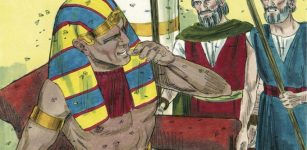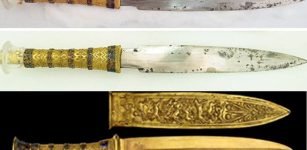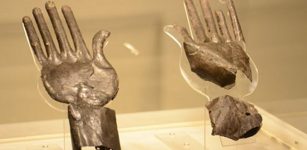Different Story Of Odin’s Sons Balder And Hoder In Norse Mythology
A. Sutherland - AncientPages.com - In Snorri's tale, Balder is the young son of Odin, the beloved of all in Asgard. He is invulnerable to all, even the most dangerous weapons, except for mistletoe, a tiny plant, which is his weakness.

Loki, a thief and trickster/shapeshifter responsible for all possible mischief and deception, knew about Balder's weakness. He made a spear from mistletoe's twig and helped Hoder shoot it at Balder, an Icelandic version of the story we described in one of our earlier articles.
However, there is also another version of the story of Balder and Hoder (Hödr).
It is somewhat different, perhaps a bit inferior, and probably not as popular as Snorri's, but it is worth mentioning.
In 'Gesta Danorum' by a Danish historian, theologian, and author Saxo Grammaticus (c. 1160 - c. 1220), Balder is a warrior supported by a group of Valkyries, supernatural women with abilities to have the power to grant victory in battle. Among others, they had a magic food, which could make Balder invincible if necessary.
Being in love with Nanna, a human female and the daughter of King Gevar, Hoder and Balder are rivals. The demi-god Balder needs the Valkyries' help, and so does Hoder, who cannot stand alone against his opponent. He, too, gets support from the women, who are eager to give him advice, and even a magical belt granting him victory.
Saxo Grammaticus describes Hoder as a good athlete, a boxer, a skilled swimmer, and highly experienced in using all kinds of weapons. He is also an accomplished harpist and talented singer who could evoke joy, hatred, sorrow, or desire with his incredible singing.
Hoder is probably the blind shepherd with the wet hat in the Finnish epic Kalevala. He kills a handsome young man and a hero, Lemminkäinen, with an arrow.
Hoder is undoubtedly a remarkable mythological figure, but it is not easy to win over Balder, the invincible demi-god and rival. To slay Balder, Hoder must gain a magic sword carefully guarded by Mimingus (Mimingr),) a woods satyr. Mimingus also possesses a bracelet that increases the wealth of its owner.

Guided by Loki, Hoder shoots the mistletoe at Baldr. Carl Emil Doepler (1824-1905) - Wägner, Wilhelm. 1882. Nordisch-germanische Götter und Helden. Otto Spamer, Leipzig & Berlin - Public Domain
Hoder has to make a long and hazardous journey to a mysterious land (probably the underworld), and he is determined to do so.
Riding in a carriage drawn by reindeer through a region of terrible cold and total darkness, he successfully captures the desperately needed sword.
Several battles were fought between Hoder and Balder. All the Aesir gods supported them, but none wanted to be involved. On one occasion, Balder was defeated, and on another, he won the battle over Hoder. Despite the victory, however, Hoder married the beloved Nanna.
Saxo says that, at last, these two (not exactly the best friends) met in the final battle after Hoder had already obtained the magic sword.
With this weapon, he badly wounded Balder, and in his last dream Hel Proserpine (Persephone) appeared to foretell his death, and so it happened.
After three days, Balder indeed died from the wounds he had been given to him by Hoder.
Odin Wants To Avenge The Death Of Beloved Son As Soon As Possible
Odin was so determined to avenge the death of his son Balder that he tried to gain the love of a princess called Rind. In Saxo's account, Odin had a son with her named Boe (instead of Vali), and this young man avenged the death of Balder, killing Hoder.
As we see, the accounts of Balder's death differ much. Snorri's tradition is preserved in Iceland, and Saxo's is in Denmark's collection. It is hard to say which version is better or more reliable.
In all sources, however, there is mention of Balder's magnificent funeral. Snorri describes how he was burned on his ship. Also, Saxo mentions the funeral and Balder's burial in a mound. He also has a reference to the ship's funeral.
Snorri says that the particular weapon that killed Balder was a mistletoe plant, but according to Saxo, this fatal weapon was a sword known in Norse heroic myths.
Mistletoe (not native to Iceland) was known in Norse heroic tradition and mentioned in the legendary Norse sagas.
Balder was invincible thanks to the Valkyries' magic, but he was not invincible when Hoder used Mimingus' magic sword. So, perhaps the sword's surface had mistletoe traces; therefore, Balder was severely wounded and had to die.
Gods and heroes in the world of myths and legends have many counterparts. Saxo's Balder and Hoder resemble two famous figures of Herebeald and Haethcyn, the sons of King Hrethel and the brothers of Hygelac in an Old English epic, Beowulf.
In an accident, Herebeald is killed with an arrow by his brother Haethcyn, whose fate is also tragic because he dies in a battle.
The incident and the father's grief over his dead boy in 'Beowulf' resemble that of Odin after the death of Balder in Snorri's and Saxo's versions.
In the famous 'Beowulf' story, we also encounter two princely warriors, one of whom, perhaps through the power of a curse or hostile magic, unintentionally becomes the slayer of the other.
Written by – A. Sutherland - AncientPages.com Senior Staff Writer
Updated on September 23. 2024
Copyright © AncientPages.com All rights reserved. This material may not be published, broadcast, rewritten or redistributed in whole or part without the express written permission of AncientPages.com
More From Ancient Pages
-
 First Peoples Of Japan: Ainu Civilization And Its Unknown Origin
Ancient Mysteries | Oct 18, 2014
First Peoples Of Japan: Ainu Civilization And Its Unknown Origin
Ancient Mysteries | Oct 18, 2014 -
 Insects Played An Important Role In The Biblical Exodus
Biblical Mysteries | Jan 13, 2018
Insects Played An Important Role In The Biblical Exodus
Biblical Mysteries | Jan 13, 2018 -
 King Tut’s Cosmic Dagger Was Not Made In Egypt – New Study Reveals
Archaeology | Feb 24, 2022
King Tut’s Cosmic Dagger Was Not Made In Egypt – New Study Reveals
Archaeology | Feb 24, 2022 -
 Neolithic ‘Zombie’ Grave Found Near Oppin In Saxony-Anhalt, Germany
Archaeology | Apr 26, 2024
Neolithic ‘Zombie’ Grave Found Near Oppin In Saxony-Anhalt, Germany
Archaeology | Apr 26, 2024 -
 Aldworth Giants: Knights Who People Tried To Erase From History
Featured Stories | Jul 2, 2015
Aldworth Giants: Knights Who People Tried To Erase From History
Featured Stories | Jul 2, 2015 -
 Sōhei And Yamabushi: Fearsome Ancient Warrior Monks Of Japan
Featured Stories | Feb 26, 2022
Sōhei And Yamabushi: Fearsome Ancient Warrior Monks Of Japan
Featured Stories | Feb 26, 2022 -
 Chogha Zanbil: Huge Ancient Still Existing Ziggurat Dedicated To God Inshushinak
Featured Stories | Mar 10, 2016
Chogha Zanbil: Huge Ancient Still Existing Ziggurat Dedicated To God Inshushinak
Featured Stories | Mar 10, 2016 -
 Secret Archaeological Excavations Have Led To The Discovery Of An Extremely Rare Ancient Roman Gold Treasure In Parc Hosingen, Luxembourg
Archaeology | Jan 20, 2025
Secret Archaeological Excavations Have Led To The Discovery Of An Extremely Rare Ancient Roman Gold Treasure In Parc Hosingen, Luxembourg
Archaeology | Jan 20, 2025 -
 Why Did Pirates And Sailors Wear Earrings?
Ancient History Facts | Feb 15, 2016
Why Did Pirates And Sailors Wear Earrings?
Ancient History Facts | Feb 15, 2016 -
 Rök Stone (Rök Runestone): Longest Runic Inscription Ever Discovered
Featured Stories | Jun 12, 2024
Rök Stone (Rök Runestone): Longest Runic Inscription Ever Discovered
Featured Stories | Jun 12, 2024 -
 The Perplexing Story Of The Seven Continents And The Seven Mysterious Races – Can The Past Foretell The Future? – Part 2
Ancient Mysteries | May 15, 2022
The Perplexing Story Of The Seven Continents And The Seven Mysterious Races – Can The Past Foretell The Future? – Part 2
Ancient Mysteries | May 15, 2022 -
 Traces Of Ancient Maya In Europe? Controversial Theory Examined
Ancient Mysteries | May 25, 2018
Traces Of Ancient Maya In Europe? Controversial Theory Examined
Ancient Mysteries | May 25, 2018 -
 Large Roman Public Latrine With 60 Wooden Seats Discovered In Bet Shean, Israel
Archaeology | Sep 25, 2023
Large Roman Public Latrine With 60 Wooden Seats Discovered In Bet Shean, Israel
Archaeology | Sep 25, 2023 -
 Seven 1,600-Year-Old Arjai Grottoes With Frescoes – Restored
Archaeology | Jul 11, 2020
Seven 1,600-Year-Old Arjai Grottoes With Frescoes – Restored
Archaeology | Jul 11, 2020 -
 Mystery Of The Silver Hands Discovered In An Etruscan Tomb Full Of Secrets
Artifacts | Jun 12, 2015
Mystery Of The Silver Hands Discovered In An Etruscan Tomb Full Of Secrets
Artifacts | Jun 12, 2015 -
 Is Mysterious Pokaini Forest An Ancient Healing Center And Anomalous Zone?
Featured Stories | Aug 13, 2018
Is Mysterious Pokaini Forest An Ancient Healing Center And Anomalous Zone?
Featured Stories | Aug 13, 2018 -
 The Wild Hunt And The Danger Of Seeing The Phantom Army Of Odin
Featured Stories | Dec 8, 2024
The Wild Hunt And The Danger Of Seeing The Phantom Army Of Odin
Featured Stories | Dec 8, 2024 -
 Mystery Of Doppelgangers And Spirit Doubles – From Ancient To Modern Times
Featured Stories | Feb 28, 2022
Mystery Of Doppelgangers And Spirit Doubles – From Ancient To Modern Times
Featured Stories | Feb 28, 2022 -
 Early European Farmers Traced To Anatolia, DNA Study Shows
Archaeology | Jan 5, 2016
Early European Farmers Traced To Anatolia, DNA Study Shows
Archaeology | Jan 5, 2016 -
 Stunning Colorful Ancient Roman Mosaic With Found Under Aldi Supermarket Site In UK
Archaeology | Mar 20, 2023
Stunning Colorful Ancient Roman Mosaic With Found Under Aldi Supermarket Site In UK
Archaeology | Mar 20, 2023
